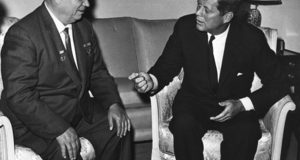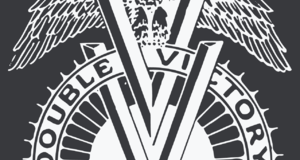America in the Post War Period
By
2009, Vol. 1 No. 10 | pg. 1/1
KEYWORDS:
The end of World War II was not just the end of a war, but also the beginning of a tense and dynamic period that affected society on all levels. This “postwar” period, as it became known, shaped the world as we know it today; likewise, the period was shaped itself both by the war that had preceded it, and the powerful forces that surrounded it. As the energy of fundamentally different ideologies—Communism and Democracy—collided with advances in science such as the nuclear bomb, a dangerous environment ensued that created an atmosphere of paranoia throughout the world and especially, within America. This atmosphere is known broadly as the “Cold War.” While the Cold War played out step-by-step between the United States and the Soviet Union, it was simultaneously playing out in the everyday lives of the masses within their borders. Paranoia, nevertheless, was not an effect that followed immediately after the close of the War. In fact, the United States had enjoyed an extended period of economic expansion during the war, and following the war the U.S. economy continued with great strength for more than a decade.1 Life in America, consequently, was arguably better than it had ever been. The middle class had swelled, unemployment rates were some of the lowest in history, and the “American Dream” was for many families a reality. In addition to the positive economic situation, the United States had become the most powerful country in the world; more importantly, America was the first and only country with the atomic bomb.2 This significant military advantage lasted for only a few brief years, however, until the Soviet Union successfully tested their first atomic bomb in August 1949.3 This, at least, put a damper on the mood of post-war America. Tony Judt, author of Postwar, characterizes an arms race of unprecedented scale in the subsequent decade, writing, “the two Great Powers of the day were arming themselves to the hilt and preparing for the eventuality of a thermonuclear war.”4 For Americans, the “paranoia” often associated with the Cold War began primarily on the day the Soviets announced their successful test.It is in this same period that the political forces of Communism and Democracy collide head-on. Judt claims, “it was in these post-war years, between 1947 and 1953, that the line dividing East from West, Left from Right, was carved deep into European cultural and intellectual life.”5 The United States was clearly on one side of this divide, representing Western Democracy, with the Soviet Union and the Soviet Bloc planted squarely on the other side. The defeat of the Germans, although unarguably a success for both parties, had left the U.S. and the Soviet Union without a common foe; and without an enemy to unite the two countries, their drastic ideological differences quickly established each as the other’s ultimate enemy.6 Despite the fact that Democracy’s founding principals are fundamentally opposed to those of Communism’s, after fighting a war against Fascism, American’s viewed Communism as another radical ideology that would eventually pose a similar threat. These sentiments were reflected in George Kennan’s Long Telegram, as he concludes, “the internal harmony of our society [will]be disrupted, our traditional way of life be destroyed, the international authority of our state be broken, if Soviet power is to be secure.”7 With this letter began the U.S. policy of “containment,” and the overall fear of Communist spillover in politically unstable regions of the world. After the Soviet’s obtained the nuclear bomb, new fears regarding the advance of Communism became inextricably intertwined with the threat posed by the bomb itself. In the film Atomic Café, released in 1982, archival footage of U.S. Senator Owen Brewster reveals him saying that the Russians obtained the atom bomb, “not through independent research, but from America, from traitors within our own ranks,” referring specifically to alleged Communists.8 The more politicians talked about “traitors within our ranks,” the more frightened the public became of impending doom from the bomb. The paranoia, furthermore, was exacerbated by the fact that political figures, like Brewster and the notorious Joseph McCarthy, were suggesting we look not only overseas for our enemy, but also to our neighbors. William Douglas, a Supreme Court Associate Justice at the time, made a keen observation of this trend: “The concentration on military means has helped to breed fear. It has bred fear and insecurity partly because of the horror of atomic war. But… Fear has many manifestations. The Communist threat inside the country has been magnified and exalted far beyond its realities. Irresponsible talk by irresponsible people has fanned the flames of fear… Suspicion has taken the place of goodwill.”9 Perhaps one of the great ironies of the time is that, in our fear of Communism, the environment in America during the height of the Red Scare took on an air of suspicion similar to that which existed within the countries on the other side of the “Iron Curtain.” Heda Kovaly, in her memoir Under A Cruel Star, frequently describes the repressive environment of fear that existed in postwar Czechoslovakia. After Kovaly’s husband was arrested on behalf of the later infamous “Slansky Trials,” she was immediately fired from her job because of her sudden poor standing within the Communist party.10 Meanwhile, in the United States, a document titled Red Channels was published by a news journal whose stated goal was to “expose the most important aspects of Communist activity in America each week.”11 The document listed more than 150 radio and TV writers, producers, and actors rumored to be “anti-American” and supportive of Communist ideals. Consequently, nearly all those listed lost their jobs and were unable to get new work within the industry. In retrospect, one can draw parallels between the nervousness of Americans at seeming “anti-American,” and the fear of Czechs, behind the Iron Curtain, of seeming sympathetic to the West. Another element that helped to propagate paranoia was the U.S. Government’s ongoing effort to promote nuclear preparedness. Scientists today would scoff at most of the suggestions laid out by the government on radio programs, in print, and on film; they ranged from building family fallout shelters to the cartoon jingle that hums, “duck… and cover!” The film Atomic Café shows clips of children as they practice hiding under their desks at school, diving for cover in the streets, and dropping quickly to the ground on a family picnic. This sense that “the Bomb” might explode at any moment permeated American culture.12 The relationship between the threat of Communism and the threat of nuclear war was, therefore, circular and self-propelling. Without the bomb, Communism did not present a physical threat to America; this is highlighted by the fact that the true height of the Red Scare in the 50’s did not occur until after the Soviet Union had obtained the Hydrogen Bomb and built a stockpile of nuclear warheads. Nevertheless, if it weren’t for the deep divide that separated the “Communists” of the East from the “Capitalists” of the West, the bomb itself would not have posed the same threat, and thus would not have induced the same degree of fear. The Cold War years—and as a result, the environment of paranoia—represented the mixing of incompatible social ideologies with weapons so powerful that using them was akin to self-destruction; historically, it was the greatest game of Brinkmanship ever played. Endnotes1.) Jorgensen, Dale W. "Productivity and Postwar U.S. Economic Growth." The Journal of Economic Perspectives 2 (1988): 23-41. 2.) Tony Judt, Postwar : A History of Europe Since 1945, New York: Penguin Books, Limited, 2005, 117-18. 3.) Tony Judt, Postwar : A History of Europe Since 1945, New York: Penguin Books, Limited, 2005, 247 4.) IBID 5.) Tony Judt, Postwar : A History of Europe Since 1945, New York: Penguin Books, Limited, 2005, 197 6.) IBID 7.) George F. Kennan, "The Long Telegram," letter to Secretary of State, 22 Feb. 1946, Moscow. 8.) Atomic Cafe, prod. Jayne Loader, Kevin Rafferty and Pierce Rafferty, 1982. 9.) William O. Douglas, "The Black Silence of Fear," The New York Times Magazine, 13 January 1952. 10.) Heda M. Kovaly, Under a Cruel Star: A Life in Prague, 1941-1968, trans. Helen Epstein and Franci Epstein, New York: Holmes & Meier, Incorporated, 1997. 11.) “Red Channels: The Report of Communist Influence in Radio and Television.” Counterattack (1950), 214 12.) Atomic Cafe, prod. Jayne Loader, Kevin Rafferty and Pierce Rafferty, 1982. Suggested Reading from Inquiries Journal
Inquiries Journal provides undergraduate and graduate students around the world a platform for the wide dissemination of academic work over a range of core disciplines. Representing the work of students from hundreds of institutions around the globe, Inquiries Journal's large database of academic articles is completely free. Learn more | Blog | Submit Latest in History |
















